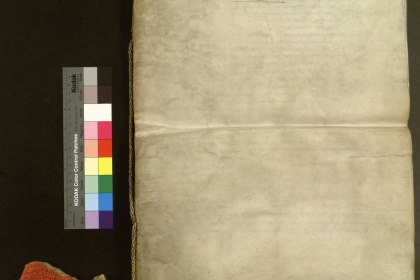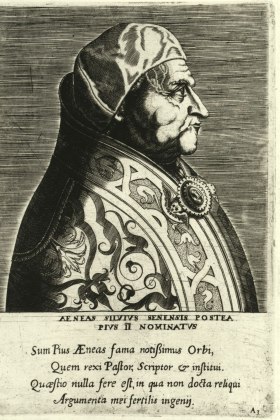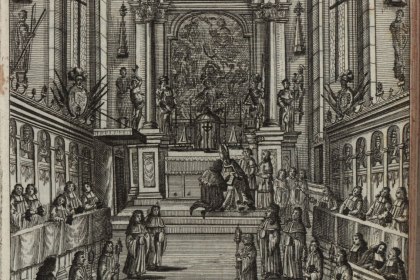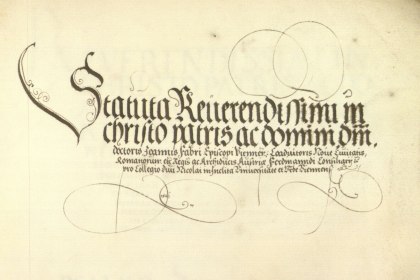University reforms under Ferdinand I.
“The university must constantly be reformed”. When looking at the various university organization laws of the past years, one might imagine this sentence to have been uttered in the context of the recent restructuring of the university system. In actual fact, it stems from the time of humanism, in which also many changes occurred in regard to administration and teaching at the University of Vienna.
Two main points of the reform movements have not changed over the centuries: the question of the university’s funding and closely related to this the state’s influence on the administration and teaching.
The University of Vienna, which had been one of the most frequented universities north of the Alps until the start of the 16th century, experienced a dramatic decline in student numbers beginning in 1520. With this recession also came a decline in the educational standard.
Humanistic criticism of university teaching
The reasons for this mostly lay in the propagation of humanistic and reformatory ideas. Although the Landesfürst (local sovereign) called humanists to Vienna, it proved difficult to integrate them into the university system. The humanists regarded the topics that were taught and the methods used to do so as outdated and were more oriented towards the monarchy. A spiteful comment by Aeneas Silvius Piccolomini (the later Pope Pius II) about the Austrian theologian Thomas Ebendorfer is a good example for humanistic criticism of the late medieval teaching methods: Piccolomini said Ebendorfer was “a not unimportant theologian”, who had written “not unuseful historical works”, but he had been reading about the first chapter of the book of Isaiah for 22 years and had still not come to an end…
Even though the humanists working in Vienna were hostile towards the university, there were some loose connections, mainly through the “Poetenkolleg” (“Poet College”), at which humanistic topics were taught. The lectures held there were however not obligatory for the students at the Faculty of Arts.
An existence-threatening crisis
The spread of Martin Luther’s theses were a much larger threat to the university. He completely rejected universities as papal institutions. However, he revised his early general contempt for education and demanded that it should first and foremost serve the purpose of educating people about true Christianity. Not least due to this it would also be in the interest of the (Protestant) authorities to expand and support the educational system. In the 16th century, many Protestant schools and universities were built in the Empire, entering into competition with the existing (Catholic) institutions. Particularly in Vienna, where students had overwhelmingly belonged to the “Rhenish nation” (South and South-West Germany) until the 16th century, this led to a massive drop in matriculation numbers.
Returning epidemics and the constant threat of the Ottomans also reduced Vienna’s appeal as a place of study. The decrease in students led to high losses of income for the university, which could not be balanced out by the insufficient allowances from the sovereign. This loss of financial power amplified the university’s general plight and endangered its continued existence.
Measures to improve the desolate university
Archduke Franz Ferdinand, who had ruled the Austrian hereditary lands since 1521, wanted to strengthen and expand the local sovereign’s power towards the estates. In this context he – and the Protestant authorities – realized the importance of schools and universities as training centers for future officials and loyal subjects. To achieve this goal, on the one hand the educational standard had to be raised again to compete with the newly founded universities. On the other hand, reformatory ideology had to be prevented from being spread by way of education. The University of Vienna had already been infiltrated by Protestants as it was: While the Faculty of Theology de facto did not exist anymore due to the growing loss of members, Luther’s supporters represented a majority in the three worldly faculties. In 1524, they refused to write evaluations of Protestant texts. The jurists and physicians stated that this was not part of their duties, while the members of the Faculty of Arts argued that they could not evaluate books they were not allowed to read – after all, since 1520 it had been forbidden to read Luther’s works.
Radical reforms were necessary for the University of Vienna to be able to fulfill the duties bestowed upon it by the local sovereign: well-founded training for future officials based in Catholicism.
Increase of university finances and greater control by the Landesfürst
The first investigations in 1524 already showed that the insufficient financial funds were the university’s greatest problem. A commission put in place by the Lower Austrian government suggested in 1528 to leave St. Ulrich monastery’s abandoned assets in Wiener Neustadt to the university and to have the prelate periodically collect money for it.
Due to the general political circumstances (siege of Vienna in 1529) these suggestions were only picked up again a few years later, and were recorded in the so-called “First Reform Law” on August 2, 1533. Further measures to improve university finances were the review and expansion of the (private) scholarship system, which was put under the control of the royal superintendent. He was supposed to inspect the bursae and scholarships at least once a year to remedy possible deficiencies. The number of academic chairs was also reduced to enable higher salaries.
In 1534 there was a crucial change in the university administration: Formerly, the university assembly had decided on important questions, but at that point the Consistory (originally a court assembly) became the central governing body of the university. Apart from the rector as head of the university and the officials from the faculties and nations (deans and procurators), the representatives of the bishop of Vienna and the Landesfürst – university chancellor and superintendent – received a seat in the Consistory. Especially the superintendent’s position was upgraded. Nominally, he ranked behind the rector and the chancellor, but in fact he soon took on a leading role, since he managed the university’s finances. As an official of the local sovereign he was first and foremost beholden to the ruler: He took his oath in front of him and was the sovereign’s “eyes and ears” in the university.
Standardization of the studies and re-Catholicization of the university
The curriculum was reorganized through the “Second Reform Law” of 1537. The number of salaried chairs, as well as the taught topics, was strictly regulated and the necessary lectures for each course of studies were restricted to the salaried chairs. Thus, the magisters who had been “freely lecturing” – mainly at the Faculty of Arts – became superfluous.
Another focus of the reforms was the re-Catholicization of the Viennese university. Apart from the regulations from the two reform laws, in 1536 the bursa conventors were instructed to check the orthodoxy of the students living in their bursae. Graduates from the Protestant university in Wittenberg were barred from studying in Vienna. In 1554 this ban was extended to all non-Catholic universities: Only students who had studied at Catholic universities were allowed to do a doctorate in Vienna. In 1548, conversely, Austrian subjects were prohibited from studying at foreign universities, with the exception of the university in Ingolstadt which was led by Jesuits. The verification of their orthodoxy was not only restricted to students, but was also expanded to the professors in 1546.
Calling the Jesuit order to Vienna in 1551 was another important step of the Catholic reform – not only of the University of Vienna, but of the city’s whole educational system.
The results of Ferdinand I’s reforms
In 1554, the laws regarding the university passed since the 1530s were summarized and recorded once more in the so-called “Reformatio Nova”.
The goals set by Ferdinand I for these reforms had only partially been reached. The measures to re-Catholicize the university can be seen as successful, although the measures decreed by Ferdinand in this regard were not implemented in practice by his successor Maximilian II, who was much more tolerant towards Protestantism: Protestants were able to study and do their doctorates in Vienna despite the aforementioned regulations. And yet, even though Maximilian tolerated Lutherans, he still wanted to preserve the “Roman-Catholic” character of the university. This mainly concerned religious duties of the university members, such as participation in the Corpus Christi procession which was rejected by the Protestants. Under Rudolf II and Ferdinand II the anti-reformationist efforts were picked up again and led to a successful end.
Another success was the implementation of the local sovereign’s control over the university. Through the enhancement of the superintendent’s position, he became the ruler’s supervisory authority in the university.
Improving the university’s financial situation was a failure, however. Although Ferdinand I allocated goods from abandoned monasteries and payments from offices of the Landesfürst to the university, it could only enforce these with difficulty, if at all – entertainingly, one of the offices supposed to give money to the university was the salt authority, which has become a proverbial place to lodge useless complaints. Collecting the “prelate contribution” also only proceeded slowly and did not yield the expected sums. Due to these constant financial difficulties the university’s outstanding claims to the treasury mounted up to more than half a million guilders over the course of 200 years.
-

Sitzung des Universitätskonsistoriums
Der Stich zeigt eine Sitzung des Universitätskonsistoriums gegen Ende des 17. Jahrhunderts. Der Text auf dem Bild hat programmatischen Charakter. Der...
-
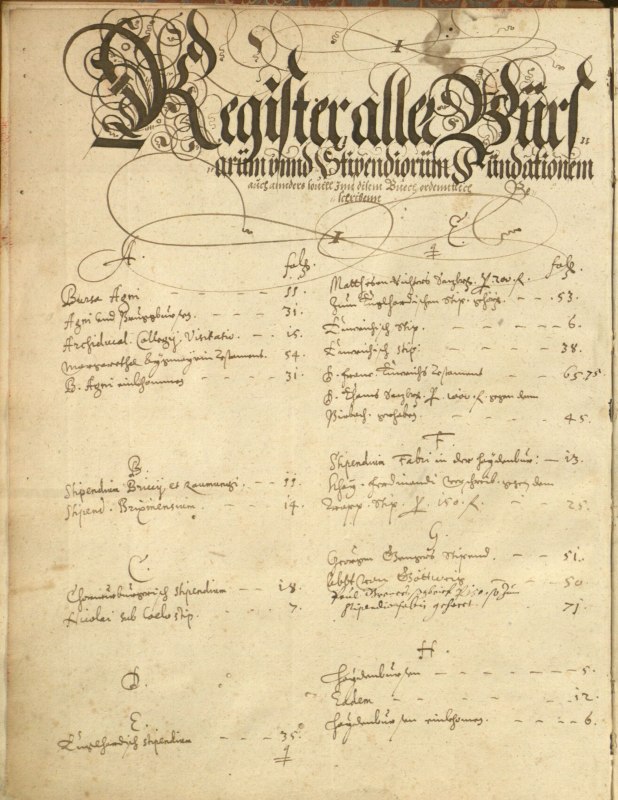
Beschreibung der Bursen, Stiftungen und Benefizien der Universität Wien
Seite 2 der für den kaiserlichen Superintendenten angefertigten Beschreibung der Bursen, Stiftungen und Benefizien der Universität Wien. Das Buch...
Zuletzt aktualisiert am 05.03.2024 - 21:42
-
Thomas Ebendorfer von Haselbach
10.8.1388–12.1.1464 -
Enea Silvio Piccolomini (Papst Pius II.)
18.10.1405–15.8.1464 -
Ferdinand I. (Habsburg), Erzherzog von Österreich
10.3.1503–25.7.1564
-
Die Universität Wien im Zeitalter der konfessionellen Auseinandersetzungen
1517–1700 -
Das Collegium trilingue
16. Jhdt.–16. Jhdt.


